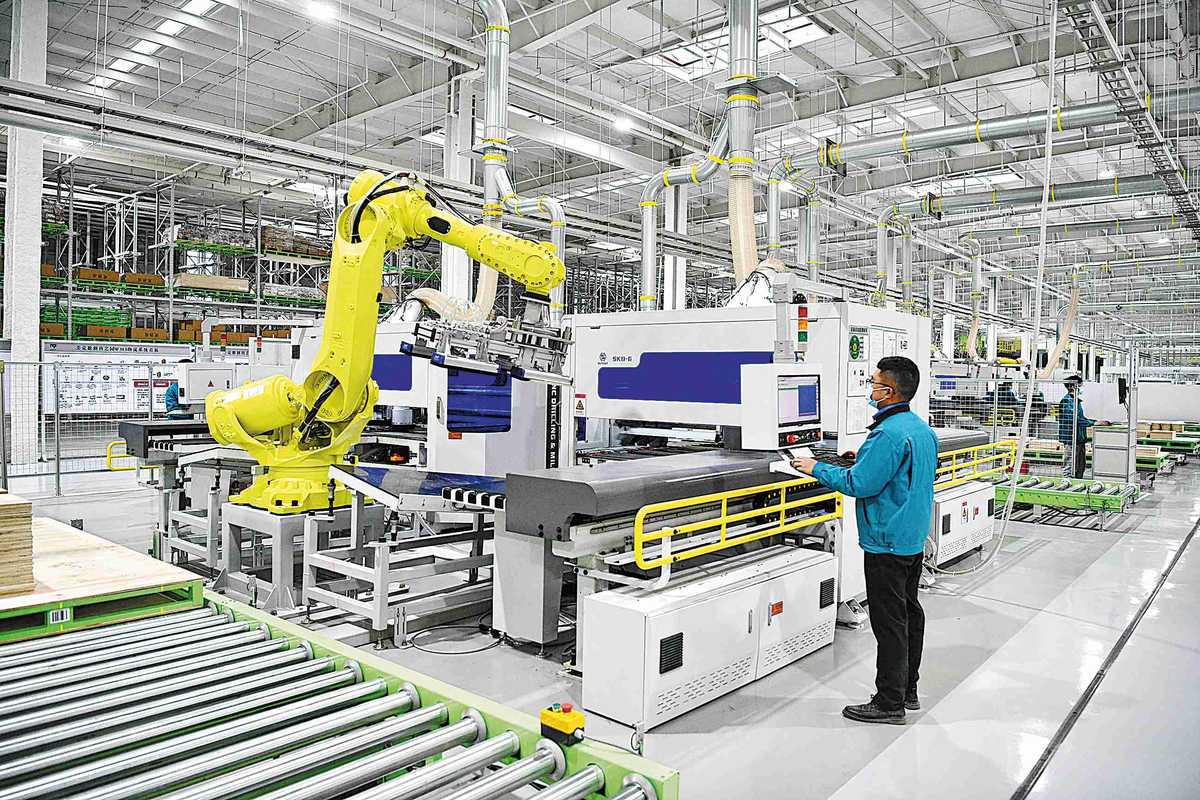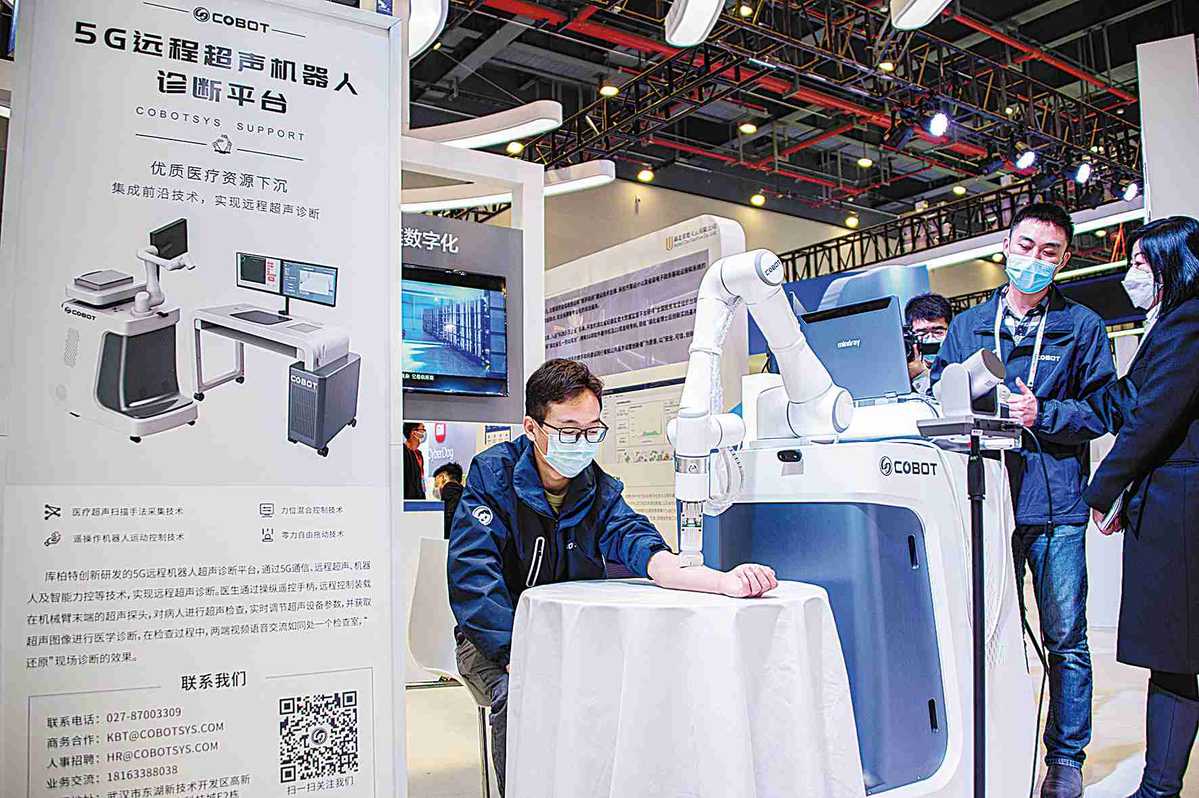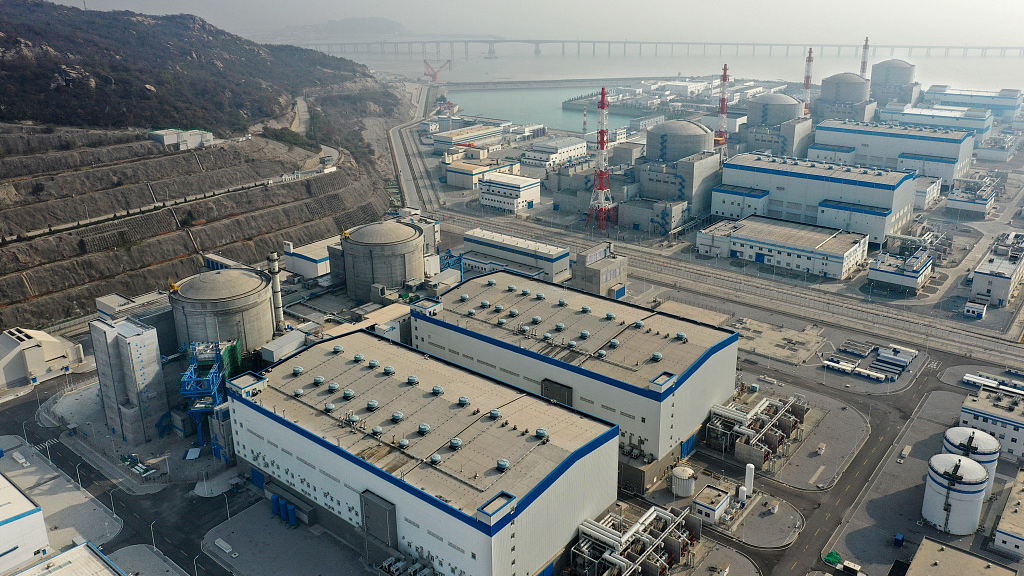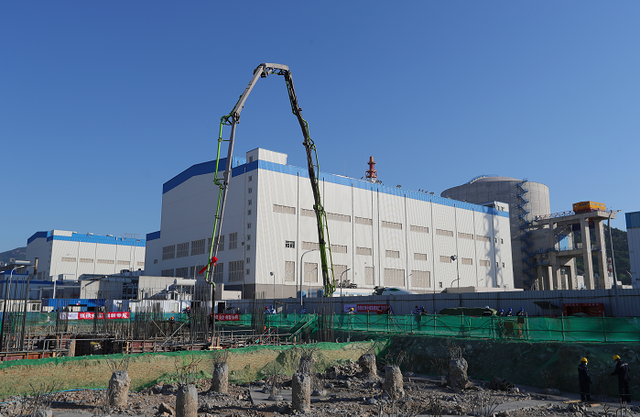The MRI machine indeed has the core tech as superconducting magnets and the coolant management system but there's a lot of little things that may be out of their reach like low noise RF electronics, precision timing circuits, etc. But those can be bought.Russia can make superconducting magnets. So they could make an MRI machine if they wanted to. Their major issue is the semiconductors really.
You are using an out of date browser. It may not display this or other websites correctly.
You should upgrade or use an alternative browser.
You should upgrade or use an alternative browser.
News on China's scientific and technological development.
- Thread starter Quickie
- Start date
Huawei reveals next-generation data center facility
By Ma Si | chinadaily.com.cn | Updated: 2022-05-27 13:46
Huawei Technologies Co revealed the key characteristics of the next-generation data center facility, as the Chinese tech titan steps up to promote low-carbon, smart data centers.
Yang Yougui, senior vice president of Huawei and CEO of Huawei's data center facility team, said on Thursday at a launch event in Dongguan, Guangdong province that technical experts and industry authorities have reached a consensus on the four characteristics of next-generation data center facilities; that is, sustainable, simplified, autonomous driving and reliable.
According to Huawei, next-generation data center facilities will be fully green and energy-efficient while maximizing the recycling of all data center materials. Meanwhile, data centers will have simplified architecture, power supply and cooling systems.
Autonomous driving refers to processes that are highly automated such as energy efficiency optimization and operation autonomy. For instance, with energy efficiency optimized, an optimal cooling strategy can be delivered via 1.4 million original combinations within 1 minute, achieving smart cooling. Operation autonomy also maximizes the value of resources, Huawei said.
At the event, Fei Zhenfu, chief technology offer of Huawei's data center facility team, unveiled a new generation of the power supply system, known as PowerPOD 3.0. The system reduces the footprint by 40 percent, cuts energy consumption by 70 percent and shortens the delivery period from 2 months to 2 weeks.
Technological innovation will be a key force in ensuring sustainable development, Huawei said, adding that it will keep making breakthroughs in products and technologies through continuous investment in R&D and with extensive cooperation with customers, ecosystem partners and industry organizations.
Hendrik_2000
Lieutenant General
using air to store energy that is novel idea
Hendrik_2000
Lieutenant General
Earth worm like robot to inspect pipeline
So I think we can conclude the existence of China's exascale computers is confirmed.
"By contrast, China’s first exascale system has been running for more than a year and has since been joined by a second, according to a recent presentation by David Kahaner, director of the Asian Technology Information Program, whose research is widely cited as the most authoritative.
China has not officially disclosed that it has two exascale systems. But their existence was confirmed late last year when scientific research run using the machines was entered for the Gordon Bell prize, with one paper taking top honours in the international supercomputing competition."
"What makes the advances all the more remarkable, according to US experts in the field, is that China’s achievement was made with local technology, after Washington blocked access to the US hardware long considered to be critical to such systems."
"By contrast, China’s first exascale system has been running for more than a year and has since been joined by a second, according to a recent presentation by David Kahaner, director of the Asian Technology Information Program, whose research is widely cited as the most authoritative.
China has not officially disclosed that it has two exascale systems. But their existence was confirmed late last year when scientific research run using the machines was entered for the Gordon Bell prize, with one paper taking top honours in the international supercomputing competition."
"What makes the advances all the more remarkable, according to US experts in the field, is that China’s achievement was made with local technology, after Washington blocked access to the US hardware long considered to be critical to such systems."
@BoraTas Sir the frustration and the excitement of Chinese semiconductor watcher, we know there are advances like SMEE SSA800 DUVL , SMIC N+2 7NM BUT they're tight lip, researching online is difficult and we're lucky @tokenanalyst and @WTAN are around to give info and guidance.So I think we can conclude the existence of China's exascale computers is confirmed.
"By contrast, China’s first exascale system has been running for more than a year and has since been joined by a second, according to a recent presentation by David Kahaner, director of the Asian Technology Information Program, whose research is widely cited as the most authoritative.
China has not officially disclosed that it has two exascale systems. But their existence was confirmed late last year when scientific research run using the machines was entered for the Gordon Bell prize, with one paper taking top honours in the international supercomputing competition."
"What makes the advances all the more remarkable, according to US experts in the field, is that China’s achievement was made with local technology, after Washington blocked access to the US hardware long considered to be critical to such systems."
Are they going to use these super computers in EUV research? They need to speed up the development of EUV machines.@BoraTas Sir the frustration and the excitement of Chinese semiconductor watcher, we know there are advances like SMEE SSA800 DUVL , SMIC N+2 7NM BUT they're tight lip, researching online is difficult and we're lucky @tokenanalyst and @WTAN are around to give info and guidance.
@henrik bro welcome to the forum, regarding your post please read the semiconductor thread, all your question and request are there for your perusal, let me give you a hint, the majority conclusion is wait for 2025 cause of the 3 core tech (Lens/optics , bench and power source), we had mastered the 2 while waiting for the 3rd to be finished its construction.Are they going to use these super computers in EUV research? They need to speed up the development of EUV machines.
5G, industrial internet helping transform heavy industries
By MA SI | China Daily | Updated: 2022-05-25 10:21

The labor-intensive iron and steel industry, as a symbol of the second industrial revolution, was often associated with images of workers toiling away in mills, sweat pouring down their faces.
But now, at a steel company in Xiangtan, Hunan province, a completely different picture is taking shape, which offers a peek into how cutting-edge technologies such as 5G and the industrial internet are transforming the traditional heavy industry.
In the control room of Hunan Valin Xiangtan Iron and Steel Co, four technicians operate joysticks to remotely control bridge cranes moving back and forth in a nearby high-temperature plant. Via a big screen that features a real-time video of plant operations, the employees monitor the processes and all the equipment moves in an orderly fashion.
"Previously, the control center had to be placed within a steel plant to allow it to control the process without a time delay. We had to work in an environment with searing temperatures, loud noises and dust. But all of this has changed due to the 5G network," said Liu Jiwen, who is in charge of the company's 5-meter plate production facility.
According to Liu, 5G's low latency and large bandwidth mean the control center can now be located in a cozy room outside the mill, and one employee can remotely operate multiple bridge cranes simultaneously, significantly boosting efficiency.
The plant is one of the 2,400 5G+industrial internet projects currently under construction in China, as the nation beefs up its industrial upgrade drive in an attempt to facilitate the marriage between digital technologies and traditional sectors.
The industrial internet refers to the convergence of industrial systems with the power of advanced computing, analytics, sensing and new levels of connectivity.
Such jargon used to be only known to telecom industry insiders. But now, the term has wider resonance with people from a wide range of sectors, with front-line workers such as employees at the above Hunan Valin Xiangtan Iron and Steel Co particularly benefiting from the technology.
Thanks to the growing application and integration of 5G and industrial internet technologies, factories in China are increasingly going digital, internet-connected and smart, experts and company executives said.
Using machine vision technologies, automatically inspecting industrial products, or workers harnessing 5G-enabled unmanned electric locomotives in underground mines to carry gold ore are all examples of industrial production becoming more efficient and safer in reality, they added.
Zhao Zhiguo, spokesman for the Ministry of Industry and Information Technology, the nation's top industry regulator, said the industrial internet has been applied in 45 sectors such as manufacturing, healthcare, energy, smart ports and mining. It not only helps enterprises boost quality and efficiency as well as reduce costs, but also drives the coordinated and efficient operation of upstream and downstream industrial chains.
"The industrial internet has been widely used in companies' research and development, design, manufacturing and operation management, with 5G accelerating its influence in key areas of production," Zhao said at a news conference last month.

He said the market size of the industrial internet has crossed the milestone of 1 trillion yuan ($157 billion) in China.
Zhao Houlin, secretary-general of the International Telecommunication Union, said earlier that China has built the largest commercial 5G network, and the nation's consumer internet and industrial internet have also entered the fast lane, putting China among the leaders in global innovation and development.
To better pounce on opportunities, last month, the MIIT unveiled a 2022 work plan for the industrial internet, which called for efforts to build 10 factories fully covered by 5G, and cultivate about 10 industrial internet public service platforms in specific regions this year.
Moreover, efforts will be made to construct regional subcenters of national industrial internet big data centers in Chongqing as well as in the provinces of Shandong, Zhejiang, Liaoning, Jiangsu and Guangdong, the plan said.
Data from the MIIT showed that the country has nurtured over 100 industrial internet platforms that have strong regional and industry influence, with 76 million units of industrial equipment connected to the platforms, which have served 1.6 million industrial enterprises from a wide range of sectors.
Hydropower stations are another example of how the 5G+ industrial internet is shaping traditional sectors. Tingzikou hydropower station in Guangyuan, Sichuan province, has deployed 5G networks from China Mobile with a private industrial internet built for the station.
With the help of 5G networks, an underwater robot can be used to automatically inspect the hydropower station's water volume to ensure safety and efficiency.
Wang Haoran, an expert from Tsinghua University's Sichuan Energy Internet Research Institute, said every three to five years, or following every major flood, Tingzikou station's basin undergoes a thorough check.
In the pre-robotics era, workers would undertake deep dives to conduct such checks, which were relatively inefficient, time-consuming and tended to interrupt power supply. "Such a process could consume three to six months and cost around 5 million yuan," Wang said.
But 5G robots can accomplish the task in about 20 days as they obviate the need to pump out water from the basin and can do some basic work like removing silt. "The cost of each check can be lowered to 700,000 yuan," said Wang.
5G-powered aerial drones are also used in dam checks. By integrating AI, big data and other cutting-edge technologies, China Mobile has built a high-precision dam surface inspection system that uses autonomous 5G drones, which can map in 3D.
These real-case applications of 5G and the industrial internet showcase the strides China has made in using these technologies. They are partly the result of the central government's push to strengthen local companies' competence in the sector, a frontier where countries around the world are scrambling to establish a beachhead.
Alex Sinclair, chief technology officer for the GSMA, an industry alliance, said: "China is betting big on the industrial internet of things to increase productivity and drive efficiency by streamlining and automating manufacturing processes via internet connectivity. Backed by positive government support, China is set to become the world's leader (in this field)."
According to the alliance, by 2025, there will be 13.8 billion industrial IoT connections worldwide, with China accounting for some 4.1 billion, or one-third of the global market.
Zhang Yong, CEO of Alibaba Group, said earlier that the industrial internet's future lies in its deep integration with the consumer internet, which will help build a vibrant market-oriented and market-driven economy.
A case in point is Alibaba Xunxi (Hangzhou) Digital Technology Co Ltd, a unit of Alibaba Group Holding Ltd, that focuses on smart manufacturing. Xunxi is using the company's cloud computing infrastructure and IoT technologies to enable agile manufacturing and on-demand production.
An Xiaopeng, chief strategy officer of Alibaba Xunxi (Hangzhou) Digital Technology Co Ltd, said clothing orders have become increasingly smaller, dropping from tens of thousands of pieces in the past to around 3,000 pieces per order now. And some online orders are now as small as 100 pieces of clothing per order. But manufacturing could not keep up with the change, which leads to heavy inventories.
To solve the problem, Xunxi helps digitalize the entire clothing industrial chain from procurement and manufacturing all the way to retail to enable on-demand and small-batch production. Xunxi also connects retailers on Alibaba's Tmall e-commerce platform directly with clothing plants to help quickly respond to consumers' changing needs, deliver orders promptly and maintain low inventories.
"Xunxi combines the advantages of the consumer internet and industrial internet. It showcases China's technological prowess in consumer-oriented internet and the nation's unique position as a manufacturing powerhouse," An added.
China's 1st nuclear steam project to turn seawater into clean energy

China began constructing the country's first nuclear-powered stream supply project for industrial purpose in Lianyungang City of its eastern Jiangsu Province, May 27, 2022. /CFP
China has started construction of its first nuclear-powered steam supply project for industrial purpose at Lianyungang City in eastern Jiangsu Province on Friday. The project will utilize heat generated by the nuclear power to convert desalinated sea water into clean, stable and efficient industrial steam and reduce energy consumption and carbon emissions.
According to China National Nuclear Corporation (CNNC), its Tianwan nuclear-powered project, which supplies industrial steam in Lianyungang City, with a total investment of 730 million yuan ($108.4 million) and construction period of 24 months, will be fully operational by the end of 2023. New desalination plants, power stations, and pumping stations will also be built under the project.

Construction site of CNNC's Tianwan nuclear-powered steam project in Lianyungang City of China's eastern Jiangsu Province, May 27, 2022. /CNNC
At present, China's industrial steam is mainly produced by coal-fired power plants or coal-fired boilers. The project will explore a new way to meet the demand for industrial steam and reduce comprehensive energy consumption as well as environmental pollution, said the CNNC.
Liu Yongsheng, the project manager, told China Media Group (CMG) that "upon completion, the project will supply 4.35 million tonnes of steam annually, reduce the annual burning of coal equivalent by 362,800 tonnes, carbon dioxide by nearly 0.97 million tonnes, sulfur dioxide by 166.88 tonnes and nitrogen oxide by 238.54 tonnes, which is equivalent to planting 2,900 hectares of trees."
